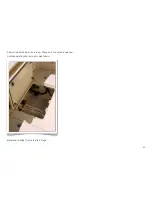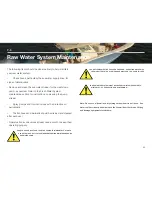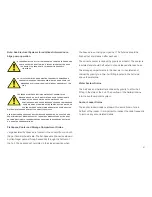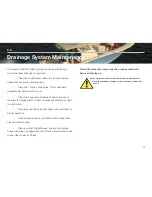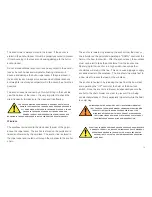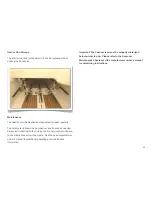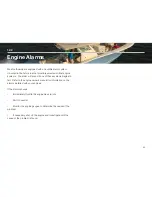
The anchor line is always stored in the locker. If the anchor is
stored in the anchor locker, it must be properly secured to prevent
it from bouncing in the locker and causing damage to the hull or
anchor locker.
Do not store additional anchors or any heavy object in the anchor
locker. Launch hooks and weights for floating markers will
bounce and damage the hull or rope locker if they are stored in
the anchor locker. Always store and secure additional anchors
and weights in a storage compartment in the cockpit, as far aft as
possible.
The anchor locker is drained by a thru-hull fitting in the hull side
near the bottom of the locker. It is very important to check the
drain frequently to make sure it is clean and free flowing.
THE ANCHOR MUST BE POSITIONED SO IT DOES NOT REST DIRECTLY
AGAINST THE SIDES OF THE LOCKER AND BE PROPERLY SECURED AT
ALL TIMES WHEN IT IS STORED IN THE ANCHOR LOCKER. A LOOSE
ANCHOR IN THE ANCHOR LOCKER WILL BOUNCE AND CAN
DAMAGE THE BOAT. DAMAGE RESULTING FROM THE ANCHOR
BOUNCING IN THE ANCHOR LOCKER IS NOT COVERED BY THE SCOUT WARRANTY.
Windlass
The windlass is mounted to the deck near the rear of the pulpit
above the rope locker. The anchor is stored on the pulpit and is
raised and lowered by the windlass. The anchor line is stored in
the rope locker and routed out through the windlass to the anchor
chain.
The anchor is lowered by releasing the anchor from the cleat or
chain binder on the pulpit and operating a “DOWN” control at the
helm or the bow foot switch. After the anchor is set, the windlass
must not be left to take the entire force from the anchor line.
Boats lying to their anchor in a high swell or heavy weather
conditions will snub on the line. This can cause slippage or apply
excessive loads to the windlass. The line should be made fast to
a bow cleat to relieve the load on the windlass.
The anchor is hauled in by releasing the line from the bow cleat
and operating the “UP” control at the helm or the bow foot
switch. Once the anchor is retrieved, independently secure the
anchor to the chain binder or a cleat to prevent it from being
accidentally released. This is especially important while the boat
is under way.
A WINDLASS MUST BE USED WITH CARE. IT IS EXTREMELY IMPORTANT
THAT YOU READ THE OWNER’S MANUAL AND BECOME FAMILIAR WITH
THE SAFETY INSTRUCTIONS AND PROPER OPERATION OF THE
WINDLASS BEFORE USING IT WITH YOUR BOAT. ALWAYS ENSURE
THAT LIMBS, FINGERS, HAIR AND CLOTHING ARE KEPT CLEAR OF
THE WINDLASS AND ANCHOR LINE DURING OPERATION.
A PARTIALLY LOWERED AND LOOSE ANCHOR CAN CAUSE CONSIDERABLE
DAMAGE TO THE HULL. DO NOT USE A WINDLASS AS A SOLE MEANS OF
SECURING AN ANCHOR IN THE BOW PULPIT. ALWAYS SECURE THE
ANCHOR LINE TO A CLEAT OR CHAIN BINDER BEFORE OPERATING
YOUR BOAT.
74
Summary of Contents for 320 LXF
Page 1: ...320 LXF Scout Boats OWNER MANUAL ...
Page 2: ...Chapter 1 Owner s Information Warranty Certification and Boat Information ...
Page 11: ...Chapter 2 Propulsion A guide to your boat s propulsion system ...
Page 32: ...Chapter 4 Fuel System An overview of the fuel system of your boat ...
Page 40: ...Chapter 5 Electrical System An overview of the electrical system of your boat ...
Page 54: ...Chapter 6 Fresh Water System An overview of the fresh water system of your boat ...
Page 59: ...Chapter 7 Raw Water System An overview of the raw water system of your boat ...
Page 65: ...Chapter 8 Drainage System An overview of the drainage system of your boat ...
Page 70: ...Chapter 9 Ventilation System An overview of the ventilation system of your boat ...
Page 73: ...Chapter 10 Exterior Equipment An overview of the exterior equipment on your boat ...
Page 83: ...Chapter 11 Interior Equipment An overview of the interior equipment on your boat ...
Page 88: ...Chapter 12 Safety Equipment An overview of the safety equipment on your boat ...
Page 99: ...Chapter 13 Operation A general guide to operating your boat ...
Page 124: ...Chapter 14 Routine Maintenance A guide to keeping your boat running in good condition ...
Page 147: ...Chapter 16 Appendix Reference documents logs and schematics for your boat ...
Page 154: ...153 ...
Page 155: ...154 ...
Page 156: ...155 ...
Page 157: ...156 ...
Page 159: ...158 ...
Page 160: ...159 ...
Page 162: ...161 ...



